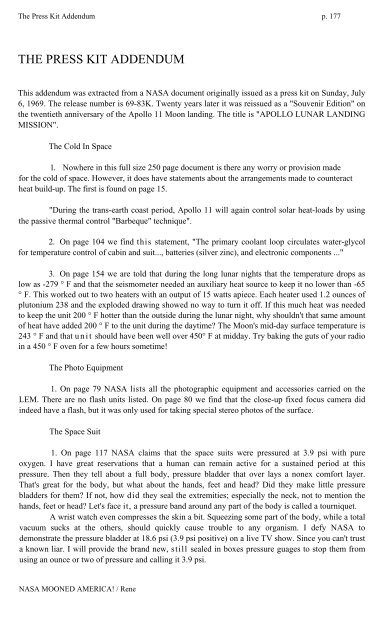Rene-NASA-Mooned-America
Rene-NASA-Mooned-America
Rene-NASA-Mooned-America
You also want an ePaper? Increase the reach of your titles
YUMPU automatically turns print PDFs into web optimized ePapers that Google loves.
The Press Kit Addendum p. 177<br />
THE PRESS KIT ADDENDUM<br />
This addendum was extracted from a <strong>NASA</strong> document originally issued as a press kit on Sunday, July<br />
6, 1969. The release number is 69-83K. Twenty years later it was reissued as a "Souvenir Edition" on<br />
the twentieth anniversary of the Apollo 11 Moon landing. The title is "APOLLO LUNAR LANDING<br />
MISSION".<br />
The Cold In Space<br />
1. Nowhere in this full size 250 page document is there any worry or provision made<br />
for the cold of space. However, it does have statements about the arrangements made to counteract<br />
heat build-up. The first is found on page 15.<br />
"During the trans-earth coast period, Apollo 11 will again control solar heat-loads by using<br />
the passive thermal control "Barbeque" technique".<br />
2. On page 104 we find this statement, "The primary coolant loop circulates water-glycol<br />
for temperature control of cabin and suit..., batteries (silver zinc), and electronic components ..."<br />
3. On page 154 we are told that during the long lunar nights that the temperature drops as<br />
low as -279 ° F and that the seismometer needed an auxiliary heat source to keep it no lower than -65<br />
° F. This worked out to two heaters with an output of 15 watts apiece. Each heater used 1.2 ounces of<br />
plutonium 238 and the exploded drawing showed no way to turn it off. If this much heat was needed<br />
to keep the unit 200 ° F hotter than the outside during the lunar night, why shouldn't that same amount<br />
of heat have added 200 ° F to the unit during the daytime The Moon's mid-day surface temperature is<br />
243 ° F and that u n i t should have been well over 450° F at midday. Try baking the guts of your radio<br />
in a 450 ° F oven for a few hours sometime!<br />
The Photo Equipment<br />
1. On page 79 <strong>NASA</strong> lists all the photographic equipment and accessories carried on the<br />
LEM. There are no flash units listed. On page 80 we find that the close-up fixed focus camera did<br />
indeed have a flash, but it was only used for taking special stereo photos of the surface.<br />
The Space Suit<br />
1. On page 117 <strong>NASA</strong> claims that the space suits were pressured at 3.9 psi with pure<br />
oxygen. I have great reservations that a human can remain active for a sustained period at this<br />
pressure. Then they tell about a full body, pressure bladder that over lays a nonex comfort layer.<br />
That's great for the body, but what about the hands, feet and head Did they make little pressure<br />
bladders for them If not, how did they seal the extremities; especially the neck, not to mention the<br />
hands, feet or head Let's face it, a pressure band around any part of the body is called a tourniquet.<br />
A wrist watch even compresses the skin a bit. Squeezing some part of the body, while a total<br />
vacuum sucks at the others, should quickly cause trouble to any organism. I defy <strong>NASA</strong> to<br />
demonstrate the pressure bladder at 18.6 psi (3.9 psi positive) on a live TV show. Since you can't trust<br />
a known liar. I will provide the brand new, still sealed in boxes pressure guages to stop them from<br />
using an ounce or two of pressure and calling it 3.9 psi.<br />
<strong>NASA</strong> MOONED AMERICA! / <strong>Rene</strong>


